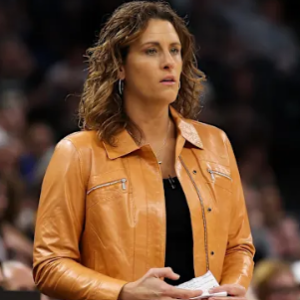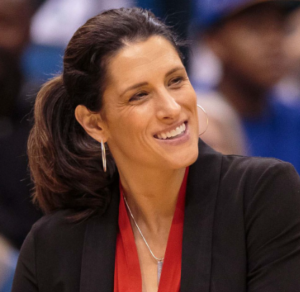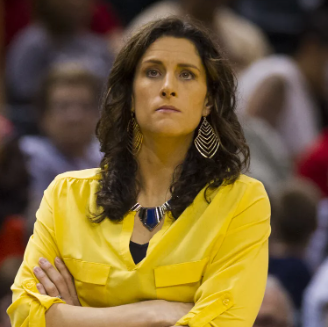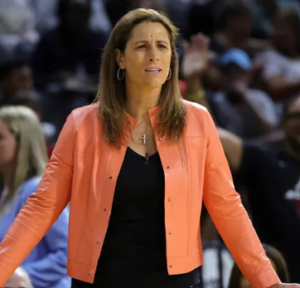Stephanie White’s return to Indiana has created a buzz that extends beyond basketball. Fans and analysts alike are eager to see how her presence will influence the Fever’s culture on and off the court
While some fans may resist the idea that a coach can impact fan behavior, others are hopeful that White’s leadership style will create a more positive and respectful environment.
The success of this endeavor ultimately depends on the willingness of fans to embrace the standards White is expected to set.
Also Read: What Happened Between Stephanie Vaquer and Giulia? WWE’s Most Surprising First Match
Table of Contents
Stephanie White’s New Chapter with the Indiana Fever
Stephanie White, known for her impactful coaching career and a firm commitment to leadership, has recently been hired as the head coach of the Indiana Fever.1
After a successful run with the Connecticut Sun, where she led the team to back-to-back semi-final appearances, White is set to usher in a new era for the Fever.
This change comes after the Fever’s recent postseason appearance under Christie Sides, who led them to their first playoff berth since 2016 but was ultimately dismissed.
Connecticut Sun sideline reporter and seasoned WNBA analyst, Terrika Foster-Brasby, has shared her thoughts on White’s appointment and the potential cultural transformation she could bring to Indiana’s franchise.
Let’s go Boilers!! https://t.co/YUaGrmTyB5
— stephanie white (@StephanieWhite) April 9, 2024
Terrika Foster-Brasby on Stephanie White’s Impact
In a recent conversation with Natalie Esquire, Terrika Foster-Brasby discussed Stephanie White’s return to Indiana, focusing not only on her skills as a coach but also on her potential to influence the fanbase and the broader WNBA community.
Foster-Brasby noted that White’s leadership could extend beyond the court, especially when it comes to addressing some negativity among a subset of Indiana Fever fans.
She highlighted White’s dedication to upholding WNBA values, pointing out that the coach is unlikely to tolerate negative or toxic behavior within the fanbase.
“She’s … most certainly not going to stand for any of the negativity that had been associated with Fever fans,” Foster-Brasby remarked, emphasizing that while not all Fever fans are problematic, a vocal minority has used the team’s platform to express views inconsistent with WNBA ideals.
Foster-Brasby believes that White’s leadership will foster a more positive and inclusive environment within the Fever community.

Stephanie White: Fan Reactions
The conversation sparked considerable discussion among WNBA fans, with opinions spanning from agreement to skepticism.2
Some fans felt Foster-Brasby’s remarks were a bit too focused on issues outside of basketball. One fan remarked, “Natalie and Terrika went on a 4-minute rant just to say that Stephanie White won’t tolerate the ‘nasty Fever fans‘ and will ‘change the culture’ in Indiana.
Lmaoo what can she do about the online trolls? Y’all need to move on and talk BASKETBALL. That is why we are all here.”
Others noted that as WNBA analysts, Foster-Brasby and Esquire may have felt obligated to address the fan culture and public perception of the Fever organization. One fan commented, “Remember they get paid by the W to be analysts,” implying that discussions around fan culture and league values are essential elements of their roles.
The Role of Social Media in Fan Culture
Foster-Brasby’s comments, particularly about online negativity, reflect a broader trend within sports where social media increasingly influences fan culture.
Many athletes and sports organizations are forced to grapple with trolls, bullying, and racial discrimination online, and the WNBA has not been exempt from this phenomenon. Foster-Brasby’s remark was likely a reference to the racial insults and discriminatory remarks that surfaced last season, particularly surrounding Iowa sensation Caitlin Clark.
Clark’s addition to the Fever roster brought an unprecedented surge in interest, driving viewership and attendance to new heights. However, it also attracted some negative behavior online, which Foster-Brasby believes White will aim to address indirectly through her leadership style.
Foster-Brasby envisions White’s approach as setting a standard of respect, both among players and fans, and hopes it will encourage more constructive engagement within the Fever fanbase.

Can Stephanie White Shift Fever Fan Culture?
The expectation for White to change the fan culture might seem ambitious, but Foster-Brasby is convinced that White’s influence could lead to a “culture shift.”3
She describes White as “the kind of leader that really exemplifies the standard that she expects to seize from her players,” suggesting that White’s commitment to these values could have a ripple effect. As White encourages her team to demonstrate respect and professionalism, Foster-Brasby believes fans may follow suit.
This culture shift would not happen overnight. Online platforms have created both a closer connection and a wider divide between fans and athletes, making it difficult to manage the behavior of online communities.
However, Foster-Brasby sees White as a coach who can lead by example, standing firm against disrespect and advocating for a fan culture rooted in support, positivity, and constructive engagement.
The Broader Impact of Leadership in the WNBA
Leadership in women’s sports, particularly in the WNBA, often extends beyond in-game strategy and player development. Coaches like Stephanie
White are frequently tasked with embodying the values of the league and setting a tone for fans, players, and other stakeholders.
The WNBA has long prided itself on being a progressive league, with an emphasis on community, social justice, and inclusivity.
White’s return to Indiana provides an opportunity to reinforce these values, especially within a fanbase as passionate as the Fever’s.

Also Read: Stephanie Vaquer (WWE): Bio, Wiki, Career, Private Life, Wrestling Style And More
Also Read: Who Is Stephanie Talbot? Cam Talbot’s Sister, Bio/Wiki, Career, Family And More






